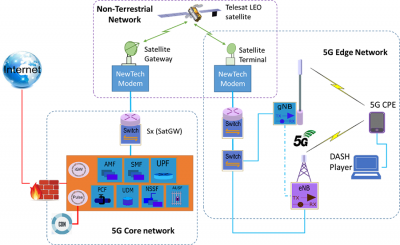Ning Wang, Barry Evans, and Rahim Tafazolli, 5G Innovation Centre, University of Surrey
Published: 26 Aug 2019

CTN Issue: August 2019

A note from the editor:
In April, we had an introduction about satellite communications for 5G, so we can’t help thinking what’s next? For instance, will our phones be able to connect to satellites directly, and also what are the new services that can be provided in addition to basic data transmission?
This month let’s continue the topic about satellite communications. Ning Wang from the University of Surrey 5G innovation center and his colleagues will tell us what’s really happening? And what will happen next?

Satellite Communications Beyond 5G – What Can Be Next?



In the April issue, we outlined the key function role of satellite communications in the context of 5G where GEO satellite links can be used as 5G backhaul connecting the core network and remote mobile edge infrastructures. Beyond this, various efforts have been recently made towards longer term integration of space and terrestrial network infrastructures. Compared to GEO satellites which introduce long latency and each alone covers limited geographic locations, networked LEO satellites become a more attractive solution to form a new layer of Internet in the space, for example, the SpaceX StarLink Project [1]. In April 2019, Telesat, Vodafone and 5GIC University of Surrey as a World first tested the performance of integrated 5G core network backhauled with a Ka-band LEO satellite, successfully streaming end-to-end 4K/8K DASH video content [2]. The main purpose is to carry out a realistic feasibility test on 5G network backhauled by LEO satellite link with evaluations on throughput, latency and handover performance between the satellite and the ground infrastructures. The picture below shows the specific network topology for the experiment carried out at 5GIC. Meanwhile, long-term research vision on the integration of LEO satellite networks with terrestrial infrastructures is being investigated as one of the key items at the ITU-T Network 2030 Focus Group [3]. This article attempts to highlight some key scenarios and associated challenges on how LEO satellite networks can play an active role towards the realisation of future parallel space Internet to its terrestrial counterpart.

Challenges in Dealing with Mega-Constellation of LEO Satellite Networks
The most intrinsically envisaged challenge is the dynamic (but predictable) changes of network topology, which leads to frequent handover events between LEO satellites and the ground infrastructures. According to the actual experiments conducted at 5GIC, a ground station is only able to connect to one particular LEO satellite passing by for less than 10 minutes (typical altitude of 1000Km) for each encounter, and the frequency of the encounters with that satellite is 3 per day. As can be anticipated, in the future if we have hundreds or even thousands of LEO satellites in space for global coverage, the high complexity of handovers will be a key issue to be addressed. The good news is that since the encounters are completely predictable, make-before-break strategies can be applied for seamless service assurance to customers.
From routing point of view, proposals from academia during the past two decades were mainly based on tunnelling approaches across the LEO satellite network running dedicated protocols which are not necessarily exposed to the ground infrastructure. There has been the vision of deploying an all-IP based solution in future LEO satellite networks for better interfacing with ground infrastructures. In this case, assuming LEO satellite networks will form their own domains (a.k.a. autonomous systems) in the space, then how BGP routing stability across boundaries between space- and terrestrial-based networks is affected by global scale of mega-constellations will also become a key technical issue [4].
Challenges in Supporting Direct User Device Access
Nowadays the default scenario is to connect user devices to the satellite network through ground stations. In this case the ground station is an ideal location to deploy various network functions including protocol translation, security and access control etc. It is not difficult to imagine the newly introduced complexity when user devices are enabled to directly connect to the LEO satellites over the head. As mentioned above, in this case it is required that all LEO satellites run the protocol stack, at least up to the IP layer, that can directly interface with the devices on the ground. Secondly, access/admission control functions will need to migrate to individual on-the-move LEO satellites rather than any ground-based network components. Potentially, one interesting issue is how to coordinate the admission control of incoming traffic among LEO satellites in order to avoid traffic congestion on those links, especially giving that each LEO satellite takes the role of both an “access” nodes interfacing user devices and at the same time a “core” node for forwarding packets along paths in the space.
Challenges in Providing Edge Computing and Storage Services in the Space
The current vision of constructing LEO satellite based parallel Internet in space is mainly for supporting data transmission as data pipes. Recent work has advocated the extension to enable content storage or even computing capabilities on board at LEO satellites [5]. According to our experiments, the round-trip time (RTT) range is between 10 and 50 milliseconds largely depending on the satellite elevation, which can potentially outperform terrestrial Internet paths across continents. While it is conceivable to localise services by bringing computing and storage capabilities closer to end users, once again such a solution faces the issue of short-time service period from each encountered LEO satellite, and thus seamless handover between neighbouring satellites need to be in place, e.g. content caching management on board. In addition, there are more fundamental technical challenges on the feasibility for lightweight LEO satellites to fulfil complex jobs beyond packet forwarding, especially concerning energy consumption requirements in such an environment.
In summary, we envisage great benefits to integrating LEO satellite networks with ground network infrastructures including both the traditional Internet and also 5G and beyond mobile networks. Towards this end, there are brand new requirements on the future evolution of IP routing/addressing paradigms as well as mobility management against the dynamicity introduced by mega-constellation behaviours of LEO satellites.
References
- M. Handley, Delay is Not an Option: Low Latency Routing in Space, ACM HotNets 2018
- https://www.surrey.ac.uk/news/worlds-first-5g-backhaul-demo-over-leo-satellite
- ITU-T Focus Group on Network 2030, https://www.itu.int/en/ITU-T/focusgroups/net2030/Pages/default.aspx
- Z. Yang, H. Li, Q. Wu, J. Wu, “Analyzing and Optimizing BGP Stability in Future Space-Based Internet”, Proc. IEEE IPCCC 2017
- H. Huang, S. Guo, K. Wang, “Envisioned Wireless Big Data Storage for Low-Earth-Orbit Satellite-Based Cloud”, IEEE Wireless Communications, Vol. 25, Issue 1, Feb. 2018
Statements and opinions given in a work published by the IEEE or the IEEE Communications Society are the expressions of the author(s). Responsibility for the content of published articles rests upon the authors(s), not IEEE nor the IEEE Communications Society.


